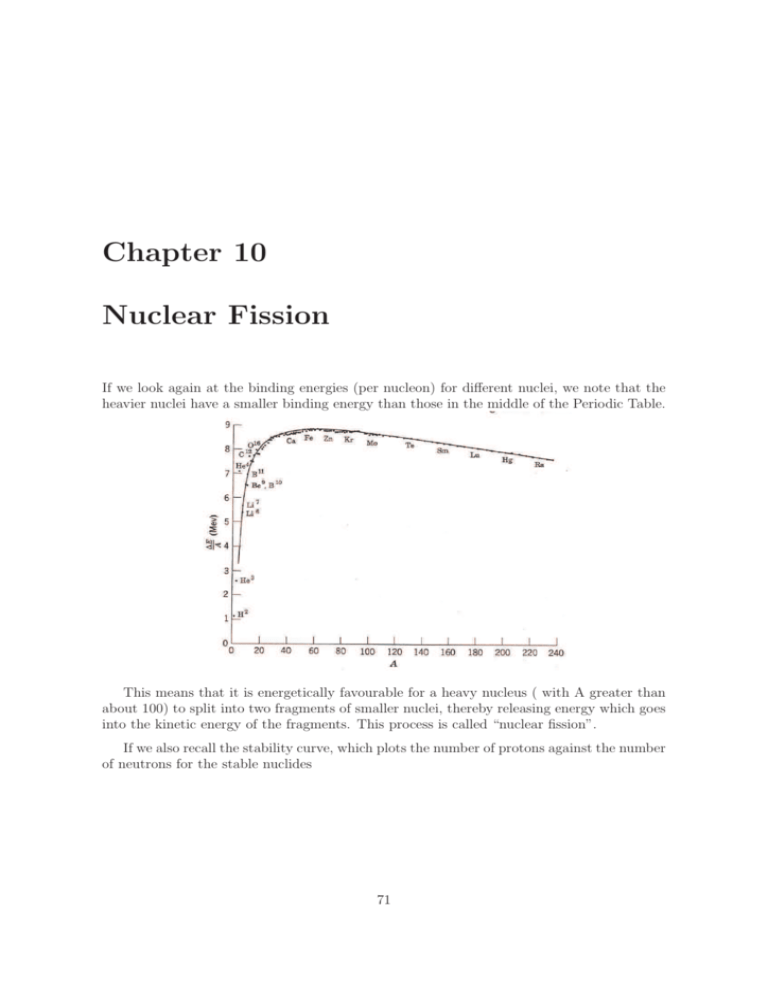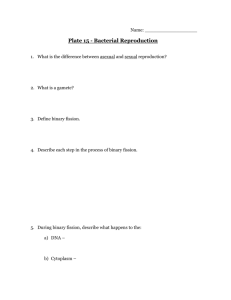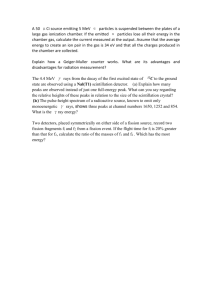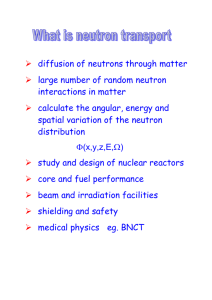Chapter 10 Nuclear Fission
advertisement

Chapter 10 Nuclear Fission If we look again at the binding energies (per nucleon) for different nuclei, we note that the heavier nuclei have a smaller binding energy than those in the middle of the Periodic Table. This means that it is energetically favourable for a heavy nucleus ( with A greater than about 100) to split into two fragments of smaller nuclei, thereby releasing energy which goes into the kinetic energy of the fragments. This process is called “nuclear fission”. If we also recall the stability curve, which plots the number of protons against the number of neutrons for the stable nuclides 71 we observe that the heavier nuclei prefer more neutrons (compared with the number of protons) than the lighter ones. This tells us that along with the fission process there will be some ‘spare’ neutrons emitted. These neutrons will also take up some of the energy released. There are usually 3 or 4 neutrons emitted per fission reaction. An example of nuclear fission is 238 92 U → 145 57 La + 90 35 Br + 3n Note that the fission fragments do not have atomic mass numbers close to one half of the atomic mass number of the parent, but rather their atomic mass numbers are separated by about 50. This is normally the case - ( the reason for this is not well-understood). 90 145 The binding energies of 238 92 U, 57 La and 35 Br are 1803 Mev, 1198 MeV and 763 MeV respectively. This means that this reaction releases 1198+763-1803 = 158 MeV of energy. Such spontaneous fission processes are known in Nature, but they are very rare. The mean lifetime for the above process is about 1017 years, compared to the mean lifetime for α-decay from the same nuclide which is about 1011 years. The reason for this is that in order to split into two parts the nucleus must first undergo a deformation of its shape ( a ‘stretching’) into an ellipsoidal shape and then to develop a ‘neck’ in the middle before it finally breaks into two nuclei. → → → s 72 s In its deformed state there are two forces acting on the nucleus. One is an increased surface energy (surface tension of a liquid drop - which explains why liquid drops are spherical), and the other is the Coulomb repulsion between the fission fragments. Together these produce a potential barrier. As in the case of α-decay, for spontaneous fission to take place the fissions fragments must undergo quantum tunnelling through this barrier. The height of the barrier is about 6 MeV. This is the same as the case for α-decay, but if we recall that the tunneling probabililty ( 2 T ∼ exp − ~ Z R′ R s 2M µ ¶ ) ZZ ′ − Q dr , 4πǫ0 r where M is the mass of the emitted particle, we see that the tunnelling probability for an α-particles is much larger than the probability for tunnelling of a much heavier fission product. Much more likely is induced fission. In this case the parent nucleus is bombarded with a neutron. If the parent absorbs the neutron, the neutron binds to the parent, releasing energy (the binding energy of the neutron) in the form of vibrational energy, which could be more than the ≈ 6 MeV required to overcome the potential barrier. 73 Where the binding energy of the extra neutron is insufficient to overcome the potential barrier, the incident neutron needs to have a minimum kinetic energy in order to be able to induce fission. In the case of 238 92 U (uranium) the binding energy of the extra neutron falls about 1 MeV short of the required energy. This means simply that fission is only induced by a neutron of kinetic energy greater than 1 MeV. On the other hand, the isotope 235 92 U has one unpaired neutron. When the nucleus absorbs an extra neutron it pairs up with this unpaired neutron and there is extra binding energy from the pairing term. This is sufficient to release sufficient energy to give the nucleus sufficient vibrational energy to overcome the potential barrier and fission occurs for this isotope for any incident neutron. Despite the fact that three or four neutrons are emitted in the fission reaction, the fission fragments still contain more neutrons than their stable isobars. This means that the fission fragments are usually unstable against β-decay. 145 For example in the case of fission of 238 92 U, the stable isobar with A=145 is 60 Nd (neo145 dynium), which means that the fragment 57 La (lanthanum) decays in three steps emitting and electron and an antineutrino at each step, until it reaches a stable nuclide. The stable 90 isobar of with A=90 is 90 40 Zr (zirconium) so the fission fragment 35 Br (bromine) decays in a five stage β-decay chain. These β-decay chains release further energy almost all of which is carried away by the energies of the electrons and antineutrinos. Direct emission of a neutron from a nuclide with too many neutrons for stability is unlikely - the point here is that there is no Coulomb repulsion and so the surface energy tends to keep the neutron bound to the parent. However, it does sometimes occur. For example, 90 the fission fragment 90 35 Br produces 36 Kr (krypton) in its first stage of β-decay, which can be produced in an excited state with sufficient energy to overcome the surface energy. This excited state can emit a neutron directly to become 89 36 Kr. This isobar is still unstable against 89 β-decay the stable isobar being 89 Y, so the Kr decays in three stages. 39 36 74 The neutrons which are emitted in a fission reaction can be absorbed by another parent nucleus which then itself undergoes induced fission. In the case of 238 92 U, however, the three neutrons that emerge come out with an energy of less than 1 MeV (most of the 158 MeV released in this reaction goes into the kinetic energy of the fission fragments), so that these neutrons do not have enough energy to induce further fission of this nuclide. However, if there is a substantial concentration of the rarer isotope 235 92 U, then these spare neutrons can 235 be captured by the nuclei of 92 U and this can indeed induce fission, because in this case there is no energy threshold below which fission is not induced. This is the principle of the “chain reaction”. Let k be the number of neutrons produced in a sample of fissile material at stage n of this chain divided by the number of neutrons produced at stage n − 1. This number will depend on how many of the neutrons produced at stage n − 1 are absorbed by a nucleus that can undergo induced fission. • If k < 1 the the chain reaction will simply fizzle out and the process will halt very quickly. This is what happens in natural uranium ore, in which the concentration of 235 92 U is so small that the probability of one of the neutrons produced is absorbed by this isotope is very small. • If k > 1, then the chain reaction will grow until all the fissile material is used up (atomic bomb). This is achieved by enriching the natural ore so that there is a sufficiently large concentration of 235 92 U. For a spherical sample the value of k grows as the neutron absorption probability which grows with the radius of the sphere. The mass of the uranium must therefore exceed some “critical mass” in order for the chain reaction to occur. • If k = 1 then we have a controlled reaction. This is needed in a nuclear reactor. The absorption is controlled by interspersing the uranium with cadmium or boron rods that absorb most of the neutrons (cadmium and boron have a high neutron capture cross-section). The reaction is controlled automatically by moving the rods in and out so that the value of k is kept equal to one. 75 76








